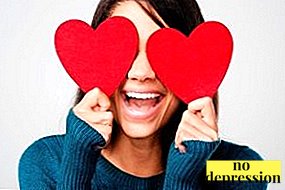Not every adult can express his feelings and emotions in words.
What can we say about the children? But they have a way to find reflection of your inner world - drawing.
From the images it is quite possible to understand what interests and excites him.
Why analyze children's drawings?

The degree of mutual understanding in the family to a greater extent dependent on adults.
Parents need to create a friendly atmosphere at home.
But it's hard to do if you don't understand what your baby feels.
Children's drawing, which was created without the intervention of adults, helps to better understand the baby. His decoding helps to give an idea of his mental state.
In addition, in time to track the alarming symptoms in the arts, you can have time to take action, saving the child from the state of stress.
Analysis of the drawings of the child will reveal:
- possible experiences and fears that the baby hides;
- what the child likes and what doesn't;
- dreams and hidden desires;
- the basis of character and its priorities;
- compliance with the current level of development of the baby and his age.
Regularly analyzing children's patterns can be learned. better understand your baby.
What do children most often draw and why?

Mostly children draw what surrounds them: family, domestic animals, nature, home and so on.
Everything that surrounds him affects the child. All emotions, experiences, fears and doubts must be reflected in his work.
The boys often draw equipment, heroes, weapons, cars. In this case, the plot they are mostly dynamic, that is, shown in motion.
Girls they prefer castles, princesses, animals, and the plot of them, on the contrary, is static.
The fact that books, cartoons, and games surround them have a very strong effect on children.
Psychological analysis
Psychological analysis of drawings of children are engaged, as a rule, social workers, psychologists. But it is important that parents also notice changes in the baby’s creativity on time.
It is important to take into account the age of the child. It is best to assess the psycho-emotional state of the child according to the picture of a 4-6 year old child. He creates already more consciously.
If we consider in general, You can identify the following patterns:
- Optimistic children draw easily and naturally. The image itself has an average size and is located in the middle of the sheet. The characters are nice, on their face you can see calm and smile.
- Closed children often they don’t draw their hands at all - this is exactly what they say about their lack of communication, shyness.
- Anxious children, unsure of themselves, often glimpse in the drawings. Their work occupies only a small part of the sheet. The characters have short arms and legs, which expresses their sense of insecurity.
In addition, anxious children often over-hatch drawings.
- Aggressive children paint hands disproportionately big with big fingers. This expresses their desire to win.

What does the plot say?
When analyzing the creativity of the child, it is necessary to pay special attention directly to the plot depicted:
- The lack of people, as well as animals, talks about problems in communication, isolation.
- The frequent depiction of dangerous animals, predators, with large teeth, claws, or horns — all reflect the current internal stress at the kid.
- Weapons, tanks, battles, dinosaurs in the boy’s drawings are the norm. Thus, he begins to realize his gender status in society. And here such plots at the girl speak about hidden aggression she has.

What does color convey?
Mood, feelings and emotions can be read by the colors that prevail in the child’s drawings.
- Yellow color speaks of immediacy, sociability, playfulness, joy.
- Red reflects both activity and dedication, as well as tension, anxiety and even anger.
- Dark green signals the constancy, stability, confidence of the baby.
- Green indicates balance. But quite often it speaks of the selfishness and stubbornness of the child.
- Calm and sensitive children often prefer blue color.
- Orange color is a symbol of bright emotions, fun, joy. But if it is too much, then it says about overexciting the baby.
- Purple prefer inventors and visionaries. Such children are receptive, sensitive and often self-doubt and what they are doing.
- Blue colour choose gullible children with artistic abilities.
- White color in the picture speaks of the equilibrium of the child.
- The black can be both a sign of decisiveness and aggressive persistence.
- Brown color reflects hard work and perseverance. But also children who prefer it are slow.

What do the details signal?
For details, it is easier to understand what is on the soul of a child. For example:
- Scary beasts, claws and teeth can talk about hidden aggression, fear and discomfort.
But sometimes it is just the result of watching a cartoon or going to the zoo.
- In the center of the picture is always the most meaningful for the child: it may be someone from friends and relatives, an animal or an object. On this too worth paying attention.
- When the center of the sheet is not filled with anything, there is an empty space left there, then this is a signal of low self-esteem of the child and his self-doubt.
- The child has placed someone of his acquaintances in a corner of a sheet - this may indicate that he has communication problems with this person.
- In the corner of the sheet the kid portrayed himself - can talk about him alone. Look, does he have enough attention? Does he have any fear of communicating with people?
- The thin legs and arms of the people depicted may indicate that the child is afraid to take on something new, not confident in yourself and your abilities.
- A big head indicates that the baby can control their emotions without suffering from impulsiveness.
Above feelings, his mind definitely dominates.
- When people are hugging or holding hands, the child is kind and warm in a relationship.
- Too many bright clothes for characters? So the baby is important that others think about him. He wants to draw attention to yourself.
- Items and figures seem to be frozen in the air and do not touch the ground - this indicates good imagination and dreaminess the author.
- There are no people in the figures - it can be a signal of communication problems.
- Pay attention to the horizon: if people are located below it, then the baby low self-esteem; if, on the contrary, above him - self-esteem is too high.
- The characters of the picture have ears - this indicates that the baby listens to the opinions of others.
- In the pictures there is no sun or clouds cover it - this is a sign that the child lack of affection, care, tenderness and warmth.
- Do the characters hold their hands behind their backs or in their pockets? Take a closer look, it may be a sign distrust and lies by the child.


What does it mean if a child draws:
- Circles. This means that the child is exploring the world around, but is more busy with his own experiences. It can be difficult for him to communicate with others, he is a bit closed.
When the baby starts drawing lines and points inside the circle, it will be a sign that he is ready to communicate.
- Crosses. Most likely the baby is very worried about something, feels a sense of guilt, punishes himself for something.
- Closed cabinets, locks and other closed items. When any closed elements are present in the drawing, they mean prohibitions and secrets to which the child is not allowed.
- A large number of small parts. Perhaps the baby does not give way to emotions, hides from the surrounding their own feelings. Also, rules and order are important to him.
- Sun, flowers, birds. Such positive and bright elements of children's creativity speak of his positive outlook on the world, emotional stability and peace of mind.
Alarms

There are the following points that can talk about possible problems:
- Well traced big eyes - Perhaps the baby has hidden anxieties and fears.
- People or animals have no mouth or eyes. - the child is difficult to communicate, he is experiencing difficulties with it.
- Extraterrestrial beings, fantastic worlds - The baby may feel uncomfortable and uncomfortable in the real world, he wants to take refuge in a fictional.
Assessment of the level of development
How to assess the compliance of the level of development of the child with his age through the drawing?
Each stage of development of the baby and his age correspond some characteristic featureswhich can be observed in the figure. The most common are the following landmarks:
- Less than 3 years. Mostly drawings consist of fuzzy images, lines and spots.
But closer to the age of 3, the outlines and more detailed images of the figures are already beginning to be seen.
- From 4 to 5 years. The plot begins to appear. The kid can independently explain what he portrayed and what inspired him for that. The figure becomes more details (clothes, figures, etc.), more clearly drawn faces.
- From 6 to 7 years. The picture already reflects not only the imagination of the child, but also his skills. He is already able to depict characters in various drawing schemes. At this time, he is also able to copy other people's styles.
- From 7 to 8 years. Objects get proportionality, the plots are traced more clearly.

Psychology of children's drawings very important for parents, as it allows you to know the needs of their baby and identify problems in the early stages.
Psychology of children's drawings:



